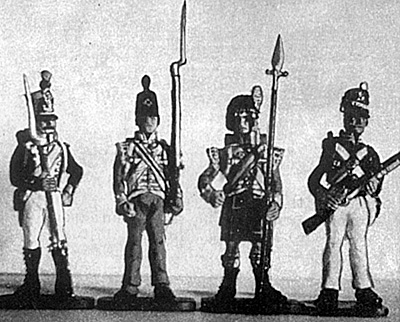
I was very interested to read this third Napoleonic Skirmish report in the April edition of the Newsletter.
The posthumous lesson for the deceased sub-lieutenant Schmidt is a very interesting one for the students of thiS period. Nearly all the light infantry and outpost manual, of this period stress very heavily the need for reserves. Unfortunately I cannot quote direct from many of these originals since I do not have them out here with me.
However, I particularly remember that the general opinion be detached to act in open or extended order and that the balance should be kept to support the action with replacements and act as a final reserve should the skirmishers be forced back. In the book of Captain Cooper, A Practical Guide for the Light Infantry Officer 1806 (facsimile edition by F.Muller Ltd) it describes how, of this detached force, several small intermediary reserves should be kept at intervals to support the firing line in the same way a sentry is supported by a picquet which is covering the main body.
On a larger scale the same principle was applied at battalion level. Within a brigade of the Light Division usually only the battalion of the 95th would be fully deployed as skirmishers whilst the British light battalion (43 or 52 Foot) and the battalion of Portuguese Cacadores would be drawn up in support. In the same way, a typical French Division in Spain would consist of about six line battalions and two light infantry battalions; in this case the line voltigeur companies could also be deployed to strengthen the skirmish line. In both of these examples there was a strong reserve avail, able either to support the attack or to cover a withdrawal.
The muskets of this period had a very limited firepower as individual pieces and hence the large masses of troops firing at relatively short range where accuracy was not important. Also by staggering the discharge over half-companies and other sub-units it was possible to prevent the situation where the whole battalion was defenceless for about 20-30 seconds whilst they all frantically reload. In the skirmish this aspect was much more critical since if a soldier was re-loading and unsupported the enemy could run the intervening 60-150 yards and shoot at point-blank range. With an empty musket at this date an infantryman was very vulnerable particularly against a horseman, even with his bayonet fixed. Light troops of this period moved and fought in files of two men for this purpose; the front man would fire and the second man would move forward to cover him whilst he re-loaded. When he had virtually finished the covering man would fire in his turn and the sequence would be repeated. Added to the fact that a marksman would spend longer picking his target at a longer range the rate of fire of a skirmish line could be as much as half as slow as volley firing. This point is nearly always overlooked in wargames and in these actions it is most critical.
In this last skirmish consider how things might have fared if the Prussians had been operating in files:
Moving in open order with two files on the flanks they would have reached the walls on the ridge before the French. The four skirmishers advance round the ends of the wall with the rest held back in reserve. After the opening exchange of fire from the flanks of the wall the file-men would have been able to take care of any wounded buddies. Sergeant Schnieder could then have done the job he was employed to do, namely to cover his officer and take charge if he was disabled. Having drawn the Frend volley the reserve could have moved up to the wall to await the impetuous charge. These five remaining muskets at point blank range would have changed the outcome completely.
Nevertheless I enjoyed this article by Mr. Cocks very much and look forward to seeing more Napoleonic Skirmish reports. As with the characters and timing involved in the Western Gunfight gamei I think the Napoleonic wars provide an excellent period for this style of wargames presentation.
Back to Table of Contents -- Wargamer's Newsletter # 174
To Wargamer's Newsletter List of Issues
To MagWeb Master Magazine List
© Copyright 1976 by Donald Featherstone.
This article appears in MagWeb.com (Magazine Web) on the Internet World Wide Web.
Other articles from military history and related magazines are available at http://www.magweb.com